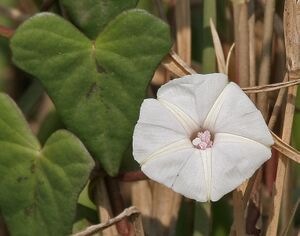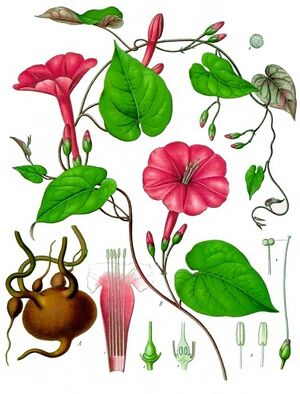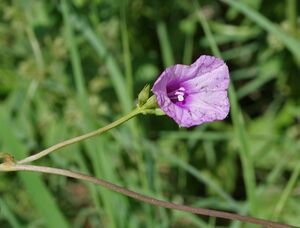Ipomoea
| Ipomoea subsp. var. | Morning glory, Moonflower | |||||||||||||||||||||||||||||||||||||||||||||||||||||||
|---|---|---|---|---|---|---|---|---|---|---|---|---|---|---|---|---|---|---|---|---|---|---|---|---|---|---|---|---|---|---|---|---|---|---|---|---|---|---|---|---|---|---|---|---|---|---|---|---|---|---|---|---|---|---|---|---|

|
|
| ||||||||||||||||||||||||||||||||||||||||||||||||||||||
| ||||||||||||||||||||||||||||||||||||||||||||||||||||||||
The genus Ipomoea (pronounced /ˌɪpɵˈmiːə/,[1] from the Greek ips ~ ipos, wormweed or bindweed, and homoeos, resembling, referring to the twining habit) is the largest in the family Convolvulaceae, with over 500 species. Most of these are called "morning glories", but this can refer to related genera also. Those formerly separated in Calonyction are called "moonflowers". The genus occurs throughout the tropical and subtropical regions of the world, and comprises annual and perennial herbaceous plants, lianas, shrubs and small trees; most of the species are twining climbing plants.
Most species have spectacular, colorful flowers and are often grown as ornamental plants, and a number of cultivars have been developed. Their deep flowers attract large Lepidoptera - especially Sphingidae such as the Pink-spotted Hawkmoth (Agrius cingulata) -, or even hummingbirds.
Second, the genus includes food crops; the tubers of Sweet Potato (I. batatas) and the leaves of Water Spinach (I. aquatica) are commercially important food items and have been for millennia.
| Standard Cyclopedia of Horticulture |
|---|
|
{{{1}}} The above text is from the Standard Cyclopedia of Horticulture. It may be out of date, but still contains valuable and interesting information which can be incorporated into the remainder of the article. Click on "Collapse" in the header to hide this text. |
Cultivation
Propagation
Pests and diseases
Many herbivores avoid morning glories like Ipomoea, as the high alkaloid content makes these plants unpalatable, if not toxic. Nonetheless, Ipomoea species are used as food plants by the caterpillars of certain Lepidoptera (butterflies and moths). For a selection of diseases of the Sweet Potato (I. batatas), many of which also infect other members of this genus, see List of sweet potato diseases.
Species










Selected species:
- Ipomoea abrupta
- Ipomoea alba – Moon Vine
- Ipomoea alpina Rendle
- Ipomoea amnicola – Red-center Morning Glory
- Ipomoea aquatica – Water Spinach, Water Morning Glory, Water Convolvulus, On(g) Choy, wéngcài (China), "Chinese spinach", "swamp cabbage"
- Ipomoea aristolochiaefolia
- Ipomoea asarifolia
- Ipomoea barbatisepala A.Gray
- Ipomoea batatas – Sweet Potato, "tuberous morning glory"
- Ipomoea batatoides Benth.
- Ipomoea bona-nox
- Ipomoea cairica – Coast Morning Glory, Cairo Morning Glory, Mile-a-minute Vine, Messina Creeper, Railroad Creeper
- Ipomoea calobra F.Muell.
- Ipomoea capillacea (Kunth) G.Don
- Ipomoea carnea – Pink Morning Glory, canudo-de-pita (Brazil)
- Ipomoea coccinea – Red Morning Glory, Redstar, "Mexican Morning Glory"
- Ipomoea cordatotriloba – Little Violet Morning Glory
- Ipomoea cordatotriloba var. torreyana – Purple Bindweed
- Ipomoea cordifolia Carey ex Voight – Heart-leaved Morning Glory
- Ipomoea costata – Rock Morning Glory, Bush Potato
- Ipomoea costellata Torr. – Crest-ribbed Morning Glory
- Ipomoea cristulata Hallier f. – Trans-Pecos Morning Glory
- Ipomoea cynanchifolia (Meisn.) Mart.
- Ipomoea daturaefolia Meisn.
- Ipomoea demerariana Choisy (= I. phyllomega)
- Ipomoea diversifolia R.Br.
- Ipomoea dumetorum Willd. ex Roemer & J.A.Schultes – Railwaycreeper
- Ipomoea eggersiana Peter
- Ipomoea eggersii (House) D.Austin – Egger's Morning Glory
- Ipomoea eriocarpa R.Br.
- Ipomoea ghika
- Ipomoea gracilis R.Br.
- Ipomoea graminea R.Br.
- Ipomoea halierca
- Ipomoea hederacea – Ivy-leaved Morning Glory
- Ipomoea hederifolia – Scarlet Morning Glory, Scarlet Creeper, Star Ipomoea, trompillo (= I. coccinea Sessé & Moc.)
- Ipomoea horrida Huber
- Ipomoea horsfalliae – Lady Doorly's Morning Glory, Cardinal Creeper, Prince Kuhio Vine
- Ipomoea imperati (Vahl) Griseb.Template:Verify source
- Ipomoea incisa R.Br.
- Ipomoea indica – Oceanblue Morning Glory, Blue Morning Glory, Blue Dawn Flower, koali awa (Hawaiʻi)
- Ipomoea jalapa (L.) Pursh.
- Ipomoea krugii Urban – Krug's White Morning Glory
- Ipomoea lacunosa L. – Whitestar Potato, Whitestar
- Ipomoea leptophylla – Bush Morning Glory, Bush Moonflower, "manroot"
- Ipomoea leucanthaTemplate:Verify source Jacq. (non Webb ex Hook., Desv. ex Ham.)
- Ipomoea lindheimeri Gray – Lindheimer's Morning Glory
- Ipomoea littoralis Blume – White-flowered Beach Morning Glory
- Ipomoea lobata – Fire Vine, "Spanish Flag"
- Ipomoea longifolia Benth. – Pink-throated Morning Glory
- Ipomoea macrantha
- Ipomoea macrorhiza Michx. – Large-rooted Morning Glory
- Ipomoea marginata (Desr.) Verdc.
- Ipomoea mauritiana – Giant Potato, Kiribadu AlaTemplate:Verify source, likam (Hawaiʻi)
- Ipomoea meyeri (Spreng.) G.Don – Meyer's Morning Glory
- Ipomoea microdactyla Griseb. – Calcareous Morning Glory
- Ipomoea × multifida – "Cardinal Climber" (I. coccinea × I. quamoclit)
- Ipomoea nil – White-edged Morning Glory, Ivy Morning Glory, Japanese Morning Glory
- Ipomoea obscura – Obscure Morning Glory, Small White Morning Glory
- Ipomoea ochracea (Lindl.) G.Don – Fence Morning Glory
- Ipomoea oenotherae Hallier f.
- Ipomoea pandurata – Wild Potato Vine, Big-rooted Morning Glory, Man-of-the-Earth, "manroot"
- Ipomoea pes-caprae – Beach Morning Glory, "goat's foot"
- Ipomoea pes-caprae ssp. brasiliensis – salsa-da-praia (Brazil)
- Ipomoea plebeia R.Br.
- Ipomoea plummerae Gray – Huachuca Mountain Morning Glory
- Ipomoea polymorpha Roem. & Schult. (= I. heterophylla R.Br.)
- Ipomoea pubescens Lam. – Silky Morning Glory (= I. heterophylla Ortega)
- Ipomoea pulcherrima
- Ipomoea purga (Wender.) Hayne – Vera Cruz Jalap (= I. jalapa auct. non L.)
- Ipomoea purpurea – Common Morning Glory, Purple Morning Glory, Tall Morning Glory
- Ipomoea quamoclit – Cypress Vine, Cypressvine Morning Glory, Cardinal Creeper, Cardinal Vine, Star Glory, "hummingbird vine"
- Ipomoea racemigera F.Muell. & Tate
- Ipomoea repanda Jacq. – Bejuco Colorado
- Ipomoea repens
- Ipomoea rubens Choisy (= I. fragans)
- Ipomoea rupicola House – Cliff Morning Glory
- Ipomoea sagittata Poir. – Saltmarsh Morning Glory
- Ipomoea setifera Poir. – bejuco de Puerco
- Ipomoea setosa Ker Gawl. – Brazilian Morning Glory
- Ipomoea shumardiana (Torr.) Shinners – Narrow-leaved Morning Glory
- Ipomoea simulans – Tampico Jalap, purga de Sierra Gorda
- Ipomoea sloteri – "Cardinal Climber"
- Ipomoea steudelii Millsp. – Steudel's Morning Glory
- Ipomoea stolonifera
- Ipomoea tenuiloba Torr. – Spiderleaf
- Ipomoea tenuissima Choisy – Rockland Morning Glory
- Ipomoea ternifolia Cav. – Triple-leaved Morning Glory
- Ipomoea thurberi Gray – Thurber's Morning Glory
- Ipomoea tricolor – Mexican Morning Glory, tlitliltzin (Nahuatl), badoh negro
- Ipomoea triloba – Littlebell, Aiea Morning Glory
- Ipomoea tuberculata
- Ipomoea tuberosa L. – Hawaiian Woodrose
- Ipomoea tuboides O.Deg. & van Ooststr. – Hawaii Morning Glory
- Ipomoea turbinata Lag. – Lilacbell
- Ipomoea velutina R.Br.
- Ipomoea violacea – Beach Moonflower, Sea Moonflower
- Ipomoea wrightii – Wright's Morning Glory
Removed from the Ipomoea genus:
- Hawaiian Baby Woodrose, Argyreia nervosa (as I. speciosa)
- Ololiúqui, Rivea corymbosa (as I. burmannii or I. corymbosa)
- Turpeth, Operculina turpethum (as I. turpethum)
IndexCH. acetosaefolia, 8. alba, 10, 18, 19. angustifolia, 17. antillana, 28. arborescens, 5. atro-caerulea, 10. atro-sanguinea, 10. aurea, 21. azurea, 10. batatas, 33. bona-nox, 30. bonariensis, 25. briggsii, 19. carletonii, 1. carminata, 10. carnosa, 8. chrysantha, 27. chryseides, 27. corymbosa, 28. cymosa, 28. dealbata, 12. dickensonii, 10. digitata, 24. dissecta, 23. ferrandiana, 13. ficifolia, 25. filicaulis, 17. fistulosa, 4. flore-pleno, 10. foliis marmoratis, 13. fuchsioides, 15. goodellii, 4. grandiflora, 13,30. hederacea, 13. heterophylla, 9. hirsutula, 11. hookeri,18. horsfalliae, 19,20. huberi, 10. insignis, 24. integrifolium, 15. jalapa, 16, 29, 32. kermesina, 10. latifolia, 30. learii, 12,14. leptophylla,2. limbata, 13. lindheimeri, 9. lindleyana, 9. littoralis, 8. longifolia, 1. macrorhiza, 29. maritime, 7. marmorata, 13. mexicana, 11. michauxii, 29. microdactylum, 15. mutabilis, 12. nil, 13. palmata, 24. pandurata, 24. paniculata, 24. perringiana, 25. pes-caprae, 7. purge, 16. purpurea, 10. rosea, 10. rubro-caerulea, 18. sagittata, 26. scabra, 13. sellowii, 25. setose, 22. sidaefolia, 28. sinitata, 23. sinuate, 23. speciosa, 26. stans, 3. stolonifera, 8. ternata, 4. texana, 4. thomsoniana, 20. tricolor, 18. tuba, 30. varia, 10. ventricosa, 30. violacea fl-pl., 10. violacea-striata, 10. wolcottiana, 6.
Gallery
-
photo 1
-
photo 2
-
photo 3
References
- ↑ Sunset Western Garden Book, 1995:606–607
- Standard Cyclopedia of Horticulture, by L. H. Bailey, MacMillan Co., 1963
External links
- w:Ipomoea. Some of the material on this page may be from Wikipedia, under the Creative Commons license.
- Ipomoea QR Code (Size 50, 100, 200, 500)

